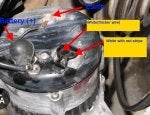Hi,
Im writing this post because I'm really desperate regarding my Charging system.
I drive a 1993 Patrol GQ with a td42 and 24v electronics.
I am currently traveling with my Patrol from Alaska to Argentina, so I need my good old Lady to be as reliable as possible.
A few weeks after the start of my journey I noticed the engine had a hard time starting, measured battery voltage and found the left side battery sitting at 11V. I replaced the battery, thinking it was broken.
Three weeks later, the same issue occurred. I changed the left battery again and added some insulation, thinking it was maybe vibrating to much.
After this I started to measure voltage regularly and it keeps dropping, not fast but consistently, about 0,2v a week.
So my conclusion was, that my alternator is not working properly.
I measured the following voltages with the engine being turned off/on:
Engine idling:
Battery left: 12,3v
Batterie right: 13,1V
Engine at 2000rpm:
Batterie left: 12,9v
Batterie right: 13,9v
Engine off:
Battery left: 12,5v
Battery right: 13,4v
Whats concerning me, is that the batterys have more voltage when the engine is turned off, than when it is idling.
Is this normal?
I also measured the voltage directly at the alternator outlet Plug (the black one with the two wires, see picture below)
Depending on the rpm the Voltage varrys between 7v and 32v, so I suppose that there has to be an external voltage regulator in the charging circuit, somewhere between the alternator and the battery.
Can someone tell me where to find it? I wasn't able to find it while tracking down the cable.
I am really thankfull for any advice on what to do now, as I cant afford to buy a new battery every two weeks.
Is there a possibility to measure if the alternator is working or not?
Thank you for any help,
Lennart
Im writing this post because I'm really desperate regarding my Charging system.
I drive a 1993 Patrol GQ with a td42 and 24v electronics.
I am currently traveling with my Patrol from Alaska to Argentina, so I need my good old Lady to be as reliable as possible.
A few weeks after the start of my journey I noticed the engine had a hard time starting, measured battery voltage and found the left side battery sitting at 11V. I replaced the battery, thinking it was broken.
Three weeks later, the same issue occurred. I changed the left battery again and added some insulation, thinking it was maybe vibrating to much.
After this I started to measure voltage regularly and it keeps dropping, not fast but consistently, about 0,2v a week.
So my conclusion was, that my alternator is not working properly.
I measured the following voltages with the engine being turned off/on:
Engine idling:
Battery left: 12,3v
Batterie right: 13,1V
Engine at 2000rpm:
Batterie left: 12,9v
Batterie right: 13,9v
Engine off:
Battery left: 12,5v
Battery right: 13,4v
Whats concerning me, is that the batterys have more voltage when the engine is turned off, than when it is idling.
Is this normal?
I also measured the voltage directly at the alternator outlet Plug (the black one with the two wires, see picture below)
Depending on the rpm the Voltage varrys between 7v and 32v, so I suppose that there has to be an external voltage regulator in the charging circuit, somewhere between the alternator and the battery.
Can someone tell me where to find it? I wasn't able to find it while tracking down the cable.
I am really thankfull for any advice on what to do now, as I cant afford to buy a new battery every two weeks.
Is there a possibility to measure if the alternator is working or not?
Thank you for any help,
Lennart






